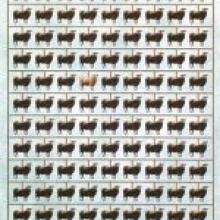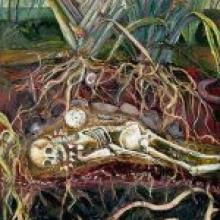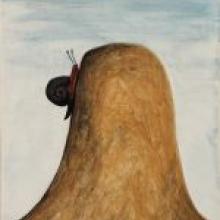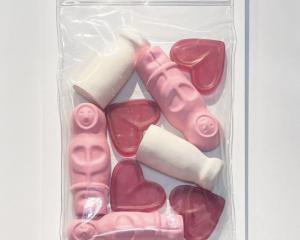Chanelle Carrick takes a look at at the latest exhibitions by Dunedin-born print-maker Kelvin Mann, painter Joanna Tokona whose dynamic ecological art seems to writhe with life before your eyes, and Noel McKenna whose paintings are refreshingly simple.

Dunedin-born artist Kelvin Mann's latest show at Gallery de Novo explores the serial nature of print-making through repetition of form.
This exhibition is a collection of skilfully executed prints, many of them depicting such animals as sheep, baboons or whales, repeated over and over to create a pattern.
In works such as Panther Chameleon, for example, each subsequent image is reproduced in a different colour, a clever reference to both the printed image and the changeable nature of the subject itself.
However, Mann also instils a sense of humour in his work, placing small but noticeable changes within his patterns to subvert and undermine them.
Black Sheep of the Family, for example, not only breaks up the surface of the work by adding a white sheep among a family of black ones, but also subverts the literal meaning of its title. Furthermore, several of these works are presented as construction sets, where game pieces in the form of figures and props are set within a kitset frame, waiting to be popped out and assembled.
These works are entertaining, the repetition of forms both fascinating and creating a sense of fun.

Several paintings by Joanna Tokona at the Moray Gallery present an up-close and personal glimpse of a world which is both unfamiliar yet right beneath our feet.
Reflecting on aspects of environmental and anthropological history, these works depict the boundaries between what is above and under ground, with tree roots and living creatures moving freely between the two.
Each of the separate large canvases seen in this exhibition is in fact part of a larger whole and, when viewed side by side, form a rich and beautiful panorama.
Painted in thick impasto brushstrokes, the trees and insects in these works seem to writhe and intertwine across the surface, snail shells curling out towards the space of the viewer.
Each of these images swarms with movement, the painted textures taking on a sense that they are living things.
These works have an uncomfortable and disturbing quality, the over-life-sized creepy-crawlies seeming to move through them in a sinister and threatening way.
Yet each of these creatures is beautiful in and of itself, rendered in luscious detail.
More disturbing perhaps are the traces of human impact in this almost otherworldly environment, visible in the presence of human bones and artefacts.
Their placement within the earth seems incongruous, out of place among the dense and arabesque forms of the tree roots and the scurrying insects.
These works have a strong ecological association, contrasting the static human presence with the dynamic forces of nature.

Noel McKenna's collection of paintings on display at the Brett McDowell Gallery is an intimate and charming portrayal of the daily lives of everyday animals.
In these works, donkeys, rats and snails are depicted in a straightforward, almost childlike way, some painted on ceramic tiles.
They are reminiscent of the drawings or illustrations found in children's books, the creatures presented not so much as animals but as characters in a story shown as part of an enchanting narrative.
McKenna's delicate paintings serve to elevate these humble creatures, separating them from their broader environment and depicting them up close, creating a sense of familiarity and wonder.
The snails, for example, are shown as they try to conquer a large hill, their progress slow but steady.
In works such as Piebald Donkey in the Snow and Brown Donkey the animals are quietly contemplative, their background setting changing only marginally to reflect different weather or times of day.
Despite their isolation and lack of context, the animals appear content, depicted as going about their daily lives.
These works are fascinating, their simplicity allowing the viewer to establish their own context and narrative.








![Untitled (c. mid 1990s, [pink 3]), by Martin Thompson, 415mm×590mm. Photo: courtesy of Brett...](https://www.odt.co.nz/sites/default/files/styles/odt_landscape_small_related_stories/public/story/2024/02/untitled_pink_3.jpg?itok=Q0aQrc9o)



